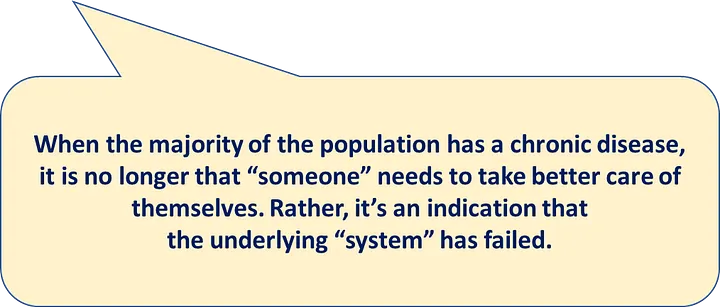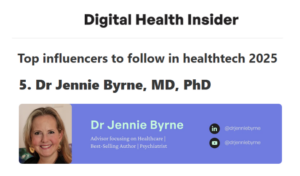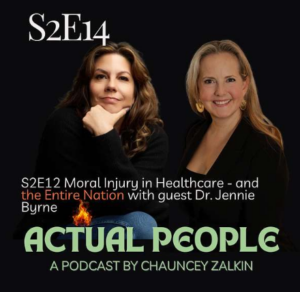Original Author: Lily C
Published in: HLWF ™ Alliance
Chronic diseases have been rising in the USA for the last 40 years. Today, the numbers are staggering— six in ten adults have one chronic disease and four in ten have two or more. The chronic disease epidemic is the leading cause of death and disability in the United States, costing $4.1T annually, and representing 90% of healthcare costs. Even more startling, chronic diseases are anticipated to further rise in the US and around the globe.

A key revelation from the Covid-19 pandemic was the susceptibility and vulnerability of the US population, especially those with pre-existing conditions. Americans suffered one of the highest rates of complications and death per capita with the worst outcomes among industrialized nations. In 2021, the US spent ~$12,914 per person on annual healthcare costs, the highest of all countries in the world. In contrast, Japan spent $4,666 and had one of the lowest Covid-19 death rates amongst wealthy nations.
The statistics paint a sobering picture. In the United States alone, more than 70% of adults carry the burden of being overweight or obese, and nearly 10% battle diabetes. Heart disease, the leading cause of death in the country claims more than 600,000 lives each year. These numbers are indicative of a systemic problem. When the majority of the population has a chronic disease, it is no longer that “someone” needs to take better care of themselves. Rather, it’s an indication that the underlying “system” has failed.

The Case for Prioritizing Healthspan
In this article, we focus on lifestyle-driven chronic diseases which represent 80% of chronic diseases and offer a significant opportunity for meaningful intervention and prevention. We have for far too long over indexed on increasing “lifespan”; rather, it’s time to reevaluate our north star with a focus on extending “healthspan”.
Healthspan (n) — the amount of life spent in good health without disease
Healthspan represents the number of years an individual lives in good health, without suffering from chronic diseases or disabilities. Unlike lifespan, which measures the total length of an individual’s life, healthspan focuses on the quality of those years. It emphasizes the importance of maintaining functional abilities, cognitive health, and overall well-being throughout the entire lifespan. Healthspan prioritizes addressing the root cause of chronic diseases.
Introduction to the Healthspan Index
To navigate this transformative journey, we introduce the healthspan index — a powerful tool to quantitatively assess an individual’s overall health and well-being across their lifespan. By considering a multidimensional approach to health, this index provides a comprehensive and nuanced evaluation of an individual. It transcends the binary presence or absence of disease, enabling personalized interventions to enhance healthy aging and longevity.
The healthspan index encompasses five pivotal categories:
(1)Functional ability
(2) Mental health
(3) Lifestyle behaviors
(4) Socioeconomic factors
(5) Health promotion and prevention
Through a series of carefully designed questions, individuals embark on a self-assessment journey.

To calculate a healthspan index score, different measures and indicators are used, such as self-reported health assessments, medical evaluations, functional capacity tests, quality of life surveys and biomarkers of aging. These assessments are often combined to generate a numerical score or index that represents an individual’s healthspan index score. Dr. Jennie Byrne who focuses on the Medicare population eloquently states that we need to find “ways to help human beings proactively manage their health and create resiliency in managing their illness.” In addition, Nicole Mason, who focuses on worklplace wellness says, focusing on healthspan may “help elevate and expand the availability mental health resources”.

A healthspan index score can lead to empowered discussions within our communities, families, employers, and with healthcare professionals as we reclaim agency of our health and drive change. Dr. Michelle Feng who specializes in mental health states “We need a healthcare system that incentivizes healthy living through an integrated system of disciplines”.
A Call to Action
By maximizing healthspan, we extend the years of vitality and functional ability, transforming the very fabric of our lives. But it goes beyond personal responsibility; it requires bold systemic changes. Governments must invest in public health initiatives, making healthy choices affordable and accessible to all. Corporations must prioritize employee well-being, fostering a culture of health. Communities must create environments that support and promote healthy living.
Introducing a healthspan index offers a powerful tool to understand the needs of our population and drive transformative actions. It is a comprehensive compass guiding us towards a society that values well-being as a fundamental pillar. This revolution is not limited to disease prevention; it is about enhancing the quality of life for every individual. Rashmi Rao, SVP of Philips Healthcare articulates that healthcare requires a “paradigm shift from caring about treating sickness to preventing sickness…. From seeing us as patients to seeing us as humans …”
The healthspan revolution demands a multi-pronged approach, combining individual empowerment, public health initiatives, and structural changes. Together, we can bridge health disparities, ensuring a more just and equitable society. It is an opportunity to rewrite the narrative of health, unleashing the potential for a healthier and more resilient future.







